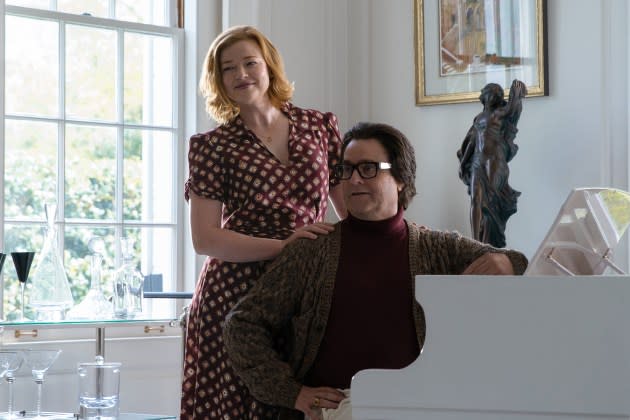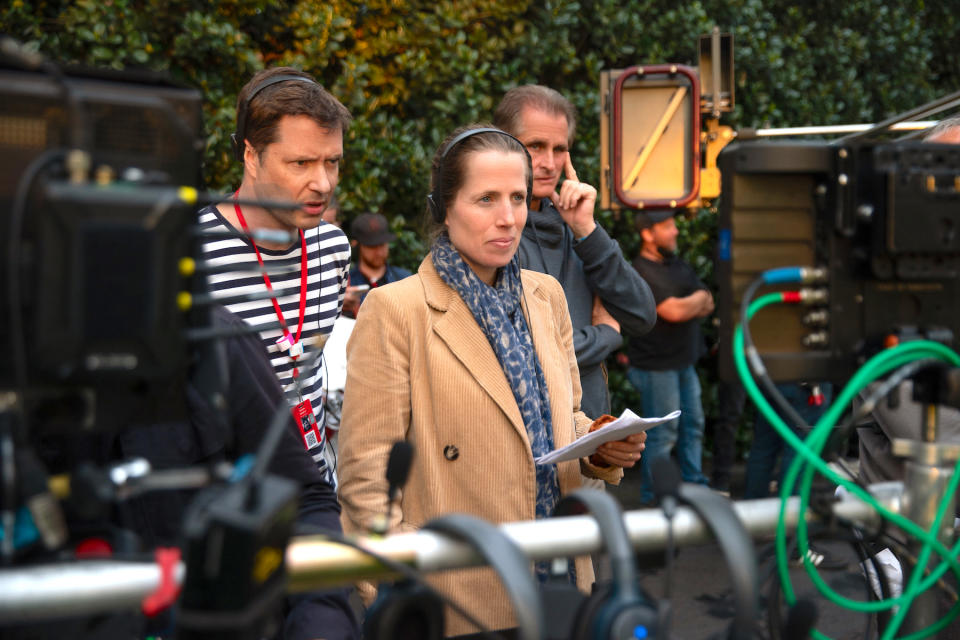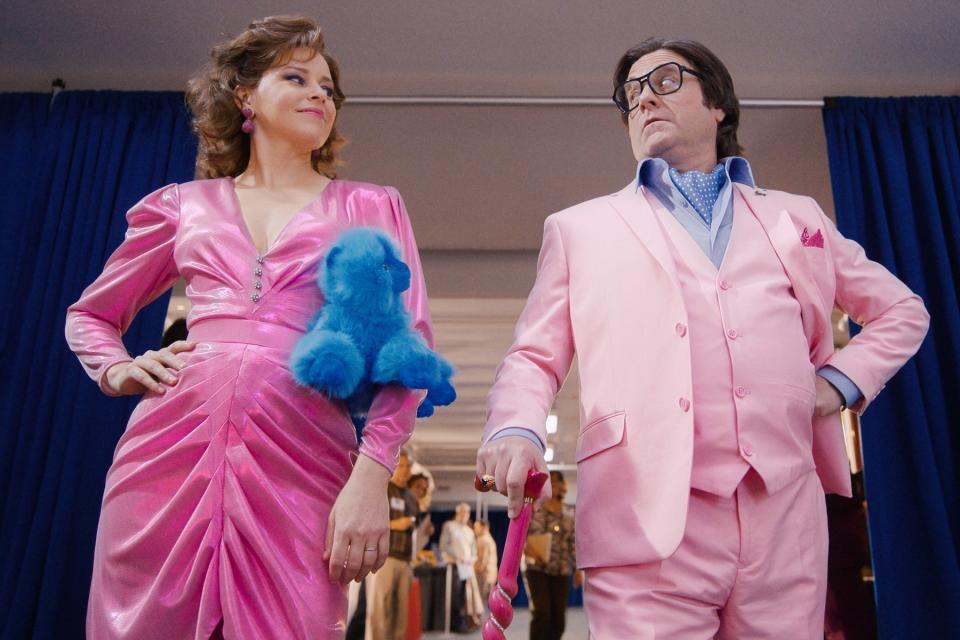How Kristin Gore and OK Go’s Damian Kulash Created ‘The Beanie Bubble’
- Oops!Something went wrong.Please try again later.
- Oops!Something went wrong.Please try again later.
- Oops!Something went wrong.Please try again later.
- Oops!Something went wrong.Please try again later.
- Oops!Something went wrong.Please try again later.
- Oops!Something went wrong.Please try again later.
- Oops!Something went wrong.Please try again later.
- Oops!Something went wrong.Please try again later.

When the Beanie Baby craze reached its apex in the late Nineties, around the time desperate suburbanites were shelling out small fortunes for the purple Princess Diana bear on eBay and ransacking shopping malls whenever rumors hit that a new shipment had arrived, screenwriter Kristin Gore and OK Go frontman Damian Kulash were barely aware it was even happening. “We were in college,” Gore says. “We were too old to be collectors. We just sort of missed it.”
“I was snobby about it,” Kulash adds. “I was leaving my teens and going into my twenties, focused on music, and was like, ‘This is so dumb. Who cares about stuffed animals?’ It just seemed like another toy fad.”
More from Rolling Stone
That toy fad is the subject of the new Apple TV+ movie The Beanie Bubble, directed by the husband and wife team of Gore and Kulash. It stars Zach Galifianakis as Beanie Babies creator Ty Warner, and Elizabeth Banks, Sarah Snook, and Geraldine Viswanathan as three overlooked women that played a pivotal role in the history of his toy company, Ty Inc. The story is told non-chronologically, and completely from the perspectives of the three women.
“It has a very unconventional structure,” says Kulash. “We did that specifically so that we can get at something other than the story of a product and man going from not rich to rich. We wanted to show the patterns in the world around him, and how he treated these women.”

The Beanie Baby bubble burst right around the turn of the millennium. At the time, Gore (daughter of former Vice President Al Gore) had just graduated from Harvard – where she edited The Harvard Lampoon – and was beginning a career in Hollywood. She produced the Steve Carrell/Channing Tatum movie Foxcatcher, and worked for years as a staff writer on Futurama.
OK Go, meanwhile, became famous for their innovative music videos after 2006’s “Here It Goes Again” became a viral hit on YouTube.
In 2016, they married each other. A couple of years later, they welcomed twins. And from the moment they met, they began thinking about ways to fuse their talents and tackle a giant project together, but nothing made sense until Gore’s agent at CAA sent her Zac Bissonnette’s 2016 book The Great Beanie Baby Bubble.
“We didn’t expect that this book would contain so much in it that really interested and inspired us,” she says. “And it wasn’t just the incredibly surreal element of little stuffed animals being treated like gold for three years. The stories of these three women behind the phenomenon were incredibly compelling to us. That became irresistible when it was paired with this larger than life exploration of what we value, who we value, and why we value things.”
The three women at the center of the story are Warner’s former business partner Patricia Roche, ex-girlfriend Faith McGowan, and former Ty Inc. employee Lina Trivedi, who created the original Beanie Baby website, harnessed the enormous potential of eBay, and allowed the company to grow into a billion-dollar enterprise. All three of them are treated horribly by Warner, denied any credit for their contributions, and ultimately discarded.
When Gore wrote the screenplay, she decided to change their names and deviate from the strict historical record. “There were some creative liberties taken, some amalgamations, some compilations,” she shares. “We weren’t interested in a documentary. We really wanted to tell this larger story, and make it feel more like a fable or a fairy tale that contains a lot of the truth in the patterns and what happened.”
For the role of Warner, they never considered casting someone other than Galifianakis. “You can’t help but love Zach even when he’s insulting people and doing terrible things,” says Gore. “We knew that he was a comedic genius, but he also has this incredible capacity for pathos and dramatic work that was really, really fun for us to showcase. It’s the perfect mix of characteristics to bring this really complicated character to life because our character of Ty is capable of cruelty and betrayal, but you also can see that it’s from some deep wounds, and some brokenness in him.”
Sarah Snook was delighted to take a break from Succession to play Sheila Warner, who is based on Faith McGowan. “After years on that show, she was happy to play someone that wears jeans and smiles and drives her own car,” says Gore. “She connected to the character’s journey really strongly.”
Australian actress Geraldine Viswanathan portrays Ty Inc. Internet innovator Maya. “People who don’t know Geraldine just completely fall in love with her in this movie because she just has so much vitality and warmth,” says Gore. “What’s funny is that both Geraldine and Sarah are Australian, but you’d never know from watching this movie.”
Rounding out the main cast is Elizabeth Banks as Robbie, Warner’s original business partner and one-time girlfriend. Banks’s experience as a director was invaluable to first-time directors Gore and Kulash. “It made it so wonderful to know that as she is acting, she’s thinking of how she would see herself through the lens,” says Kulash. “Not everyone does. It was very useful.”
Prior to this, Kulash’s primary behind-the-camera experience came from working on OK Go videos. “There’s not a lot of similarity between the two things, to tell you the truth,” he says. “The biggest difference is that everything for a movie has to be done long, long, long in advance of shooting. Every day you are essentially shooting a new little video. Instead of prepping for a month and then shooting it for three days, you’re prepping 50 videos all in a row, and then shooting them later. That allows for a lot less spontaneity and a lot less in-the-moment creativity, which is sad, since I love that part, but it also allows you to cobble something together way, way bigger than a music video.”

Kulash and Gore admit that sharing directing duties of a major motion picture had the potential to put some strain on their marriage. “Working with your spouse, especially when you’re in the process of raising twins, who are toddlers, is insane,” says Kulash. “But we like all the same stuff, for very different reasons, and get there in different ways. In particular, I tend to work backward. I go, ‘If this is the biggest splash we can make, how high up do we need to jump from? What does that cliff look like? What are the three steps you take right before you jump off it?'”
“I do it totally different,” says Gore. “I’m like, ‘Who is this person? What does the cliff mean to them? Why do they want to climb the cliff? What’s the narrative drive?’ We kind of meet in the middle.”
When they started work on the film, they had no idea that the movies BlackBerry, Air, and Flamin’ Hot were also in development. Some critics may be unable to resist comparing the four movies since they all center around cultural products of the Nineties. “I think we’ve distanced ourselves enough from a biopic or period piece of history that our movie feels very different,” says Kulash. “To us, it doesn’t feel like it’s about Ty or about Beanie Babies. We love the crazy episodes that the product created, but that was mostly a backdrop for a story we feel is much more universal.”
“You go through this movie feeling like you’re on board with these women and that the playing field is tilted against them,” he adds. “Hopefully by the end, you’re questioning whether or not this is a playing field you want to be on. Is it worth it to be a billionaire at this cost?”
The new OK Go song “This” plays over the end credits, and Kulash says the band will reconvene in the fall to finish their long-awaited fifth album for a projected early 2024 release. Their first tour since 2019 will likely follow. “Every time we want to go and plan some dates, it’s like, ‘Wait a sec! The movie release is moving a week!'” he says. “I have been too focused on this for me to be a trusty band member.”
Gore is focusing her energy now on a new novel. But she hopes that The Beanie Bubble is the first of many movies she’ll ultimately create with her husband. “Our creative ambition is to always try and get at things that we find meaningful and have a sense of joy,” she says. “This project had a perfect mix of that for us. I think any other project that offered both of those avenues would be pretty irresistible.”
Best of Rolling Stone

